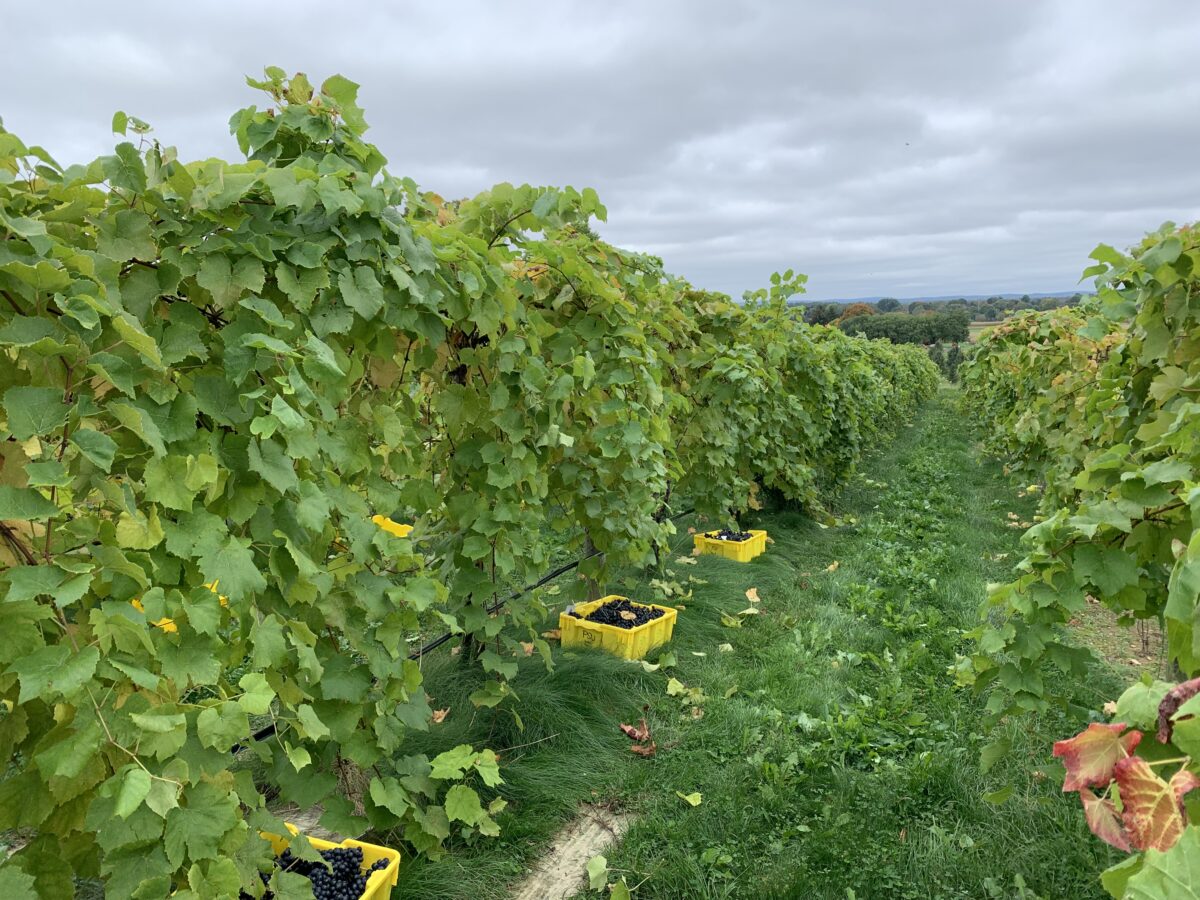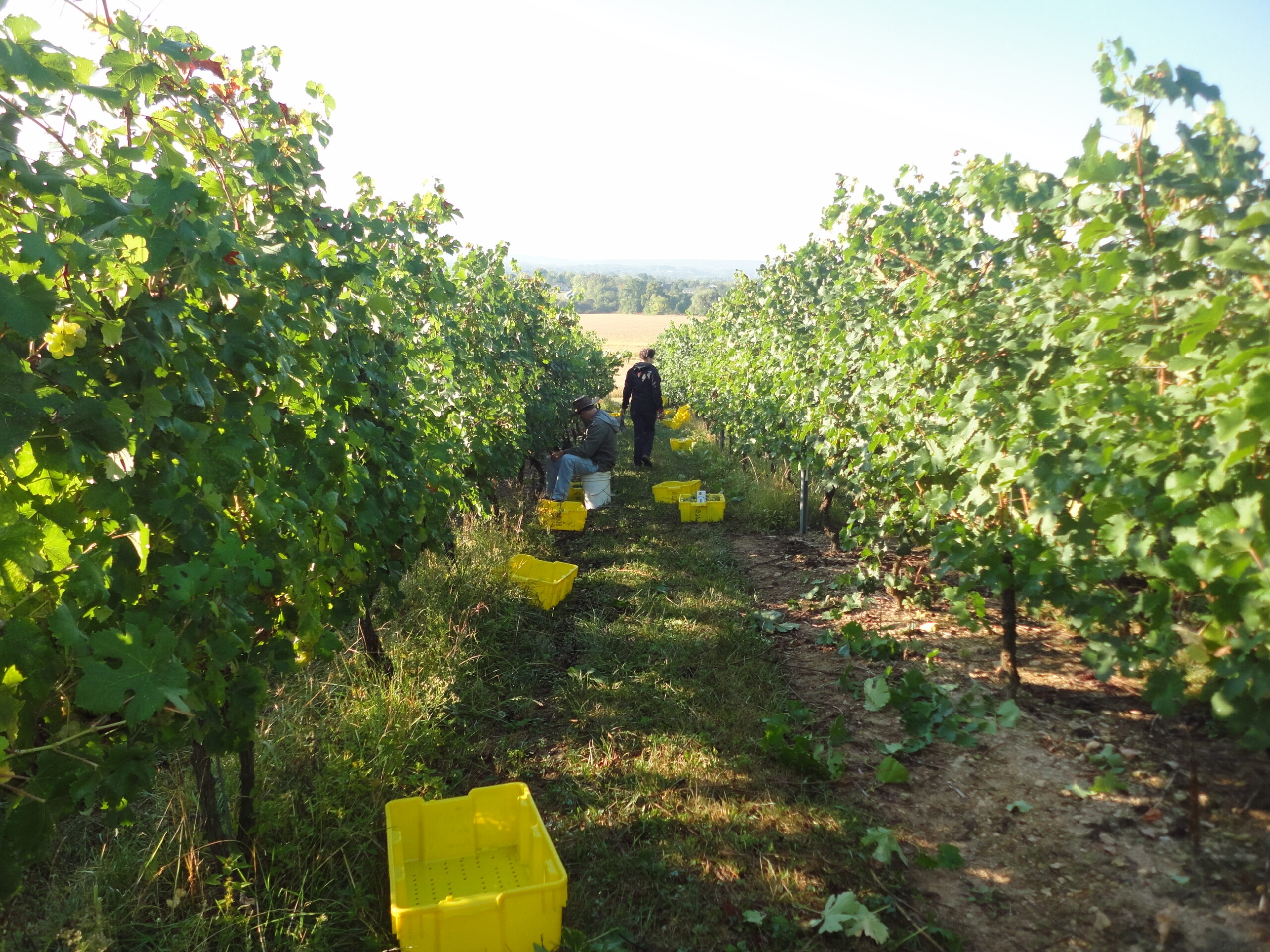
Under vine cover crops help improve soil health, and contribute to more resilient, environmentally sustainable vineyards.
If growers are to change their management practices, they need to know what is going on below ground, how the root system of their vines is impacted by competing with cover crop grasses. Perhaps the roots will be smaller, perhaps they will grow deeper—going into this research we really did not know and had very limited information. This grant was very helpful in funding a field study of the root interactions of vines and grasses and the impacts on vine root systems.
—Dr. Michela Centinari, Graduate Student Advisor
Providing Growers with More Information About Below-Ground Interactions Between Grape Vines and Cover Crops to Inform Vineyard Management Practices
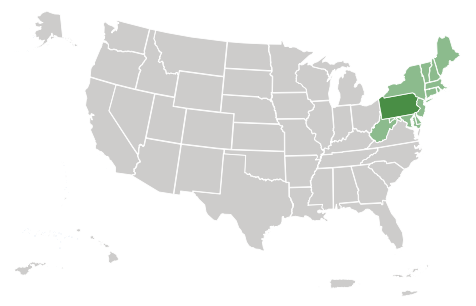
Region: Northeast
State: Pennsylvania
Grant Type: Graduate Student
Grant: GNE16-119
SARE POST-PROJECT EVALUATION IMPACT MODEL
This evaluation impact model is specific to this SARE-funded project.
Sustainability Impacts
The project grantees and stakeholders contributed to the following sustainability impacts:
- Environmental sustainability impacts
- Economic sustainability impacts
- Production efficiency impacts
Grantee Indicators
(Graduate Student, Advisor)
Project grantees (defined above) achieved sustainability impacts by engaging with the following indicators through involvement with project activities:
- Increased knowledge/skills
- Increased capacity/motivation
- Increased engagement
- Career growth
Stakeholder Indicators
(Vineyard Growers, Students, Extension Professionals)
Project stakeholders (defined above) achieved sustainability impacts by engaging with the following indicators through involvement with project activities:
- Increased knowledge/skills
The Success Story
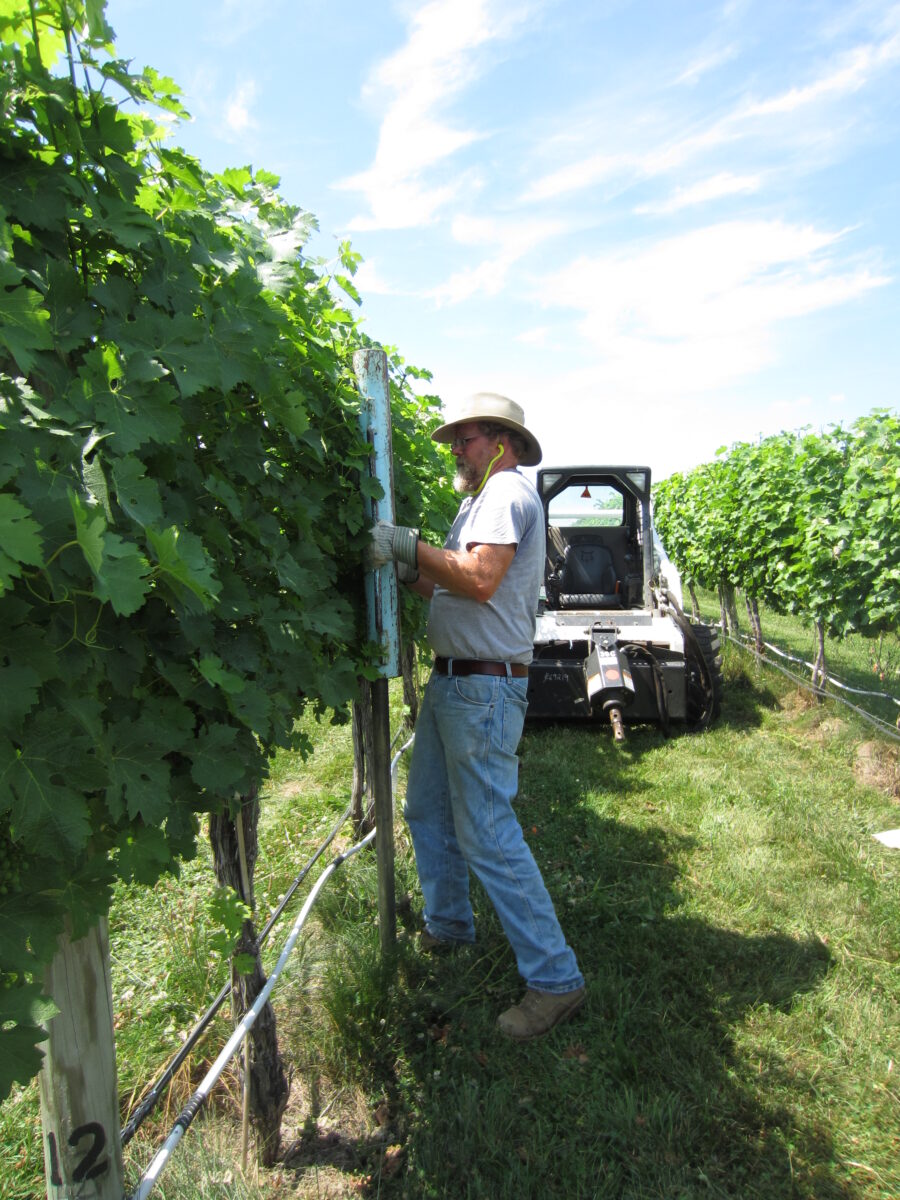
Vineyards are vulnerable to the impacts of climate change because wet years and fertile soil can lead to excessive vegetative growth on vines, which reduces the quality of the grape, while dry years cause water stress, threatening grape productivity. Establishing a vineyard requires significant upfront costs and decades of careful management to develop a resilient cropping system, with great risk to growers who may lose their investment due to plant disease and climate-related pressures. Growers also face challenges managing nutrient run-off and soil erosion on vineyard slopes, an issue further exacerbated by herbicides to control weeds. In response to these demands on growers, a SARE graduate student grant funded a study of above and below ground interactions between cover crops and young vine root systems focused on the ways cover crops affect wine grape production and the positive contributions of cover crops to soil microbiology and quality/health. Former Penn State University grad student Suzanne Fleishman conducted the research with oversight from advisor Dr. Michela Centinari. The study provided critical preliminary data on the immediate costs and benefits of under vine cover crops on grapevine root systems, resource uptake, and productivity. This led to subsequent funding, research, and professional development opportunities for the research team. Research findings provided growers and extension professionals with the information they needed to make data-driven decisions about under vine cover cropping as a management practice. Overall, the preliminary findings from this SARE project suggest that shifting management practices to include cover crop grasses serves the ecosystem and has limited impact on grape yield, thereby contributing to the long-term resilience and viability of vineyards in climates with ample water availability.

Grantee (Graduate Student, Advisor) Highlights
Funded by SARE, Dr. Suzanne Fleishman, former graduate student at Pennsylvania State University, took soil cores and installed underground root boxes on Penn State’s research vineyard to explore how vine roots cope with competition from cover crop roots. Dr. Fleishman’s SARE grantee status has had a profound impact on her professional journey. Prior to her graduate work, she had a longstanding interest in cover crops, perennial agriculture, and species diversity in agriculture. SARE funding provided a bridge for her to transition from non-profit sustainable agriculture work to scientific research. As a SARE grantee, Dr. Fleishman acquired valuable grant management and field research skills, such as fungal identification and root sampling. The technical writing skills she polished during the project resulted in her first publication, showcasing the tangible outcomes of the SARE grant. Additionally, the grant led to her involvement in extension meetings and a SARE conference, where she excelled in scientific communication and presentation, further enhancing her academic profile. The research team leveraged the SARE grant to secure subsequent grants and fellowships, including a half-million-dollar USDA AFRI grant, led by her co-advisors, and a $300,000 USDA fellowship led by Dr. Fleishman. These funds supported in-depth follow-up studies for four years following initial SARE grant funding, expanding the reach of her finding on growers in terms of demonstrating longer-term benefits and impacts. Dr. Fleishman applied her SARE project experience to develop her research on the rhizosphere microbial community on grapevine roots, which laid the groundwork for her Ph.D and subsequent publications in academic journals about the impacts of undervine groundcover and the benefits of cover crops and devigorating rootstock in vineyards. Her work on root systems and sustainable agriculture led to multiple awards, including the prestigious Penn State alumni dissertation award for dissertations that have a societal impact. She then went on to complete her post doctorate work with the USDA and recently began as the Assistant Professor of Root Biology at Penn State. Her future research will be directly informed by her experiences working on cover crops in vineyards and will focus on understanding how crop roots respond to variable soil conditions in order to support plant productivity and improve soil health.
Dr. Michela Centinari, Associate Professor of Viticulture at Penn State, acted as the grad student advisor throughout the SARE grant, strengthening her mentorship skills in her collaboration with Dr. Fleishman. Dr. Centinari benefitted from increased knowledge and capacity to innovate through the SARE project. She also concurrently managed a SARE graduate student grant (GNE16-137) focused on cost effective yield regulation in wine grapes. Dr. Centinari values the hands-on learning opportunities that SARE grants provide for her graduate student mentees such as learning to write effective proposals, oversee grants start to finish, and manage project budgets.
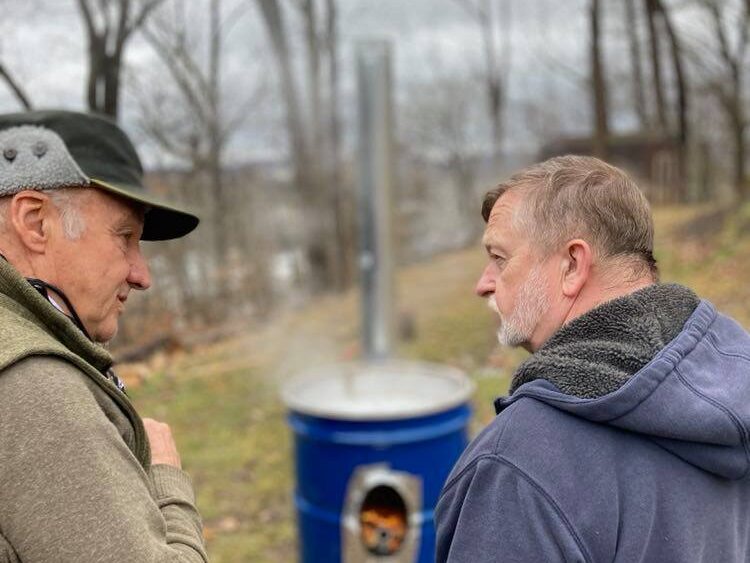
Other Stakeholder (Vinyard Growers, Students, Extension Professionals) Highlights
Dr. Fleishman’s presentation at a statewide meeting for wine grape growers provided an opportunity to share her findings with the industry. Dr. Centinari also played a pivotal role in expanding the reach of the research findings. Dr. Centinari divides her time at Penn State equally between research and extension activities to address the issues wine grape growers face on the East Coast. She continues to disseminate findings about the advantages of under vine cover crops to growers and extension professionals in her wide network. She actively oversees master and PhD students doing wine grape production research who benefit from her expertise and mentoring. Notably, Dr. Centinari’s has reached global audiences by presenting on under vine cover cropping at a climate symposium in Canada, at the International Viticulture Conference in Argentina, and at several conferences in England.
Dr. Centinari thinks the relevance of under vine cover cropping will only continue to increase as weeds become more resistant to herbicides and more growers turn to organic vineyard production. With rising consumer demand for organically produced wine, a new niche for environmentally sustainable wine production is well positioned for expansion.
.
Research on Plant Roots May Provide Crucial Information for Growers
It’s already well established that increasing species diversity in agriculture can lead to broad scale environmental improvements, particularly around soil quality. In vineyards, the cover crop grows alongside with the grapevines, which means they compete for space, water, and nutrients. Our work was looking at how to better understand exactly how the grass species and grapevines interact below ground with the goal that growers can still maintain productivity, but also get all the environmental benefits.”
—Dr. Suzanne Fleishman, Graduate Student Grantee
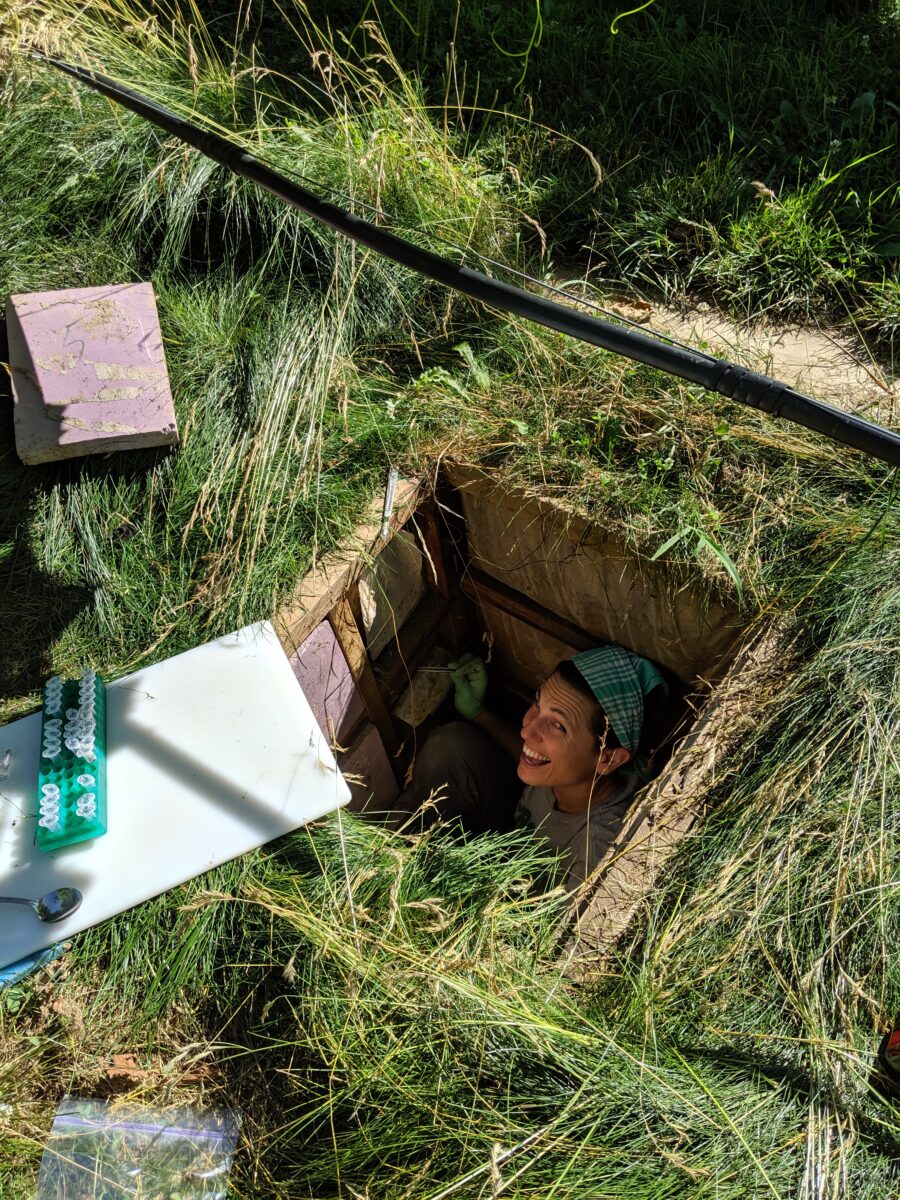
Sustainability Impacts
The study revealed that young vine roots adapt by growing deeper when cover grasses are planted so they can avoid competition for nutrients in the shallow soil. With the roots growing below the nutrient-rich shallow soil, nutrient uptake is reduced, which leads to less vegetative growth. Knowing this vital information, growers can adjust management practices and address any nutrient deficiencies through fertilization. The research findings also confirmed that the practice of cover cropping in vineyards produces a multitude of ecosystem benefits with increases in soil carbon and water infiltration, and only limited impact on grape yield in mature vineyards. Traditionally, vineyards rely on herbicides and leave the soil bare, leading to erosion and reduced soil microbiological activity. By introducing cover crops beneath the vines, soil erosion is minimized, and microbial composition can improve. This practice is part of a broader strategy to enhance species diversity in agriculture, particularly with perennial plants like grapevines. Perennial crops generally cause less disturbance and erosion as they do not need to be replanted each year, leading to positive impacts on soil quality and increased carbon sequestration. Given the large upfront investment that starting a vineyard requires, this research provides valuable insights for beginning wine grape producers to strategize for optimal productivity and environmental sustainability on their vineyards. Cover cropping is a management practice that helps producers be more agile and better prepared for intensive precipitation and longer periods of drought, leading to more resilient vineyards.
Although Short-Term Results Are Promising, Longer Studies are Still Needed
Vineyards are a long-term crop, they are often productive at least 20 years, but require a huge upfront investment for growers. When cover crop are planted, there can be as much as a 50% increase in soil carbon, elimination of herbicide, and increases in water infiltration, making it an environmentally friendly practice. The risk of yield loss in the first few years is there, but grapevines tend to adjust to the cover crop and it is possible profits can be regained over the long-term. The SARE grant was part of a five-year study and I would love it if we could extend it to 10 years because sustainability is about weighing costs and benefits. It is about that long-term perspective with some disadvantages at the start but long-term gain.”
—Dr. Suzanne Fleishman, Graduate Student Grantee
Barriers
There are inherent limitations extrapolating long-term impacts associated with a short-term research study. Long-term research that extends beyond five years on the impacts of under vine cover cropping is needed to determine in what ways the ecosystem benefits that Dr. Fleishman and Dr. Centinari observed endure and accumulate over time. Successful vineyards require growers to be future-oriented, making decisions along the way that will have lasting benefits and make their investment worthwhile. Longitudinal studies are therefore essential for helping growers to understand short-term and long- term costs and benefits of various management practices in terms of productivity, economic viability, and conservation.
